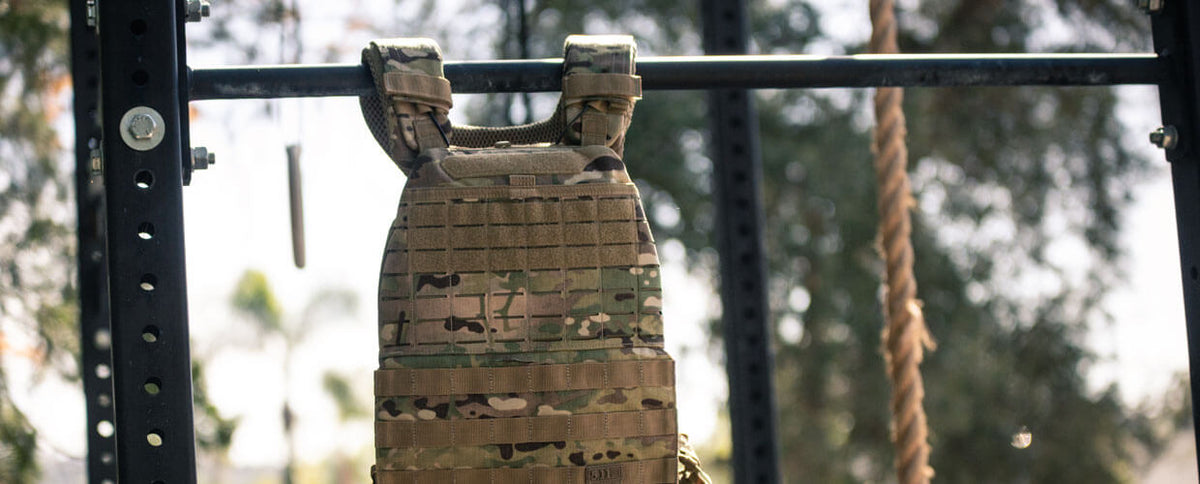What To Know About Working Out In A Weighted Vest

This article is sponsored content in partnership with 5.11 Tactical.
Curious why you’re super fit neighbor is carrying kettlebells up and down the street wearing what looks like body armor? Their hardcore fitness accessory is a military-inspired weighted vest, which has become quite the popular training trend in CrossFit boxes, gym chains, and even luxury boutique fitness studios in recent years.
Yes, people are willingly weighing themselves down while they work out. We asked the experts to break down the suck-inducing weighted vest workout trend—and how to use it to ramp up your fitness and grit.
Why Train In A Weighted Vest?
Weighted vests (or plate carriers) are typically constructed out of heavy-duty nylon and are loaded down with either pre-set or adjustable weights in the front and back.
According to Jeff Godin, Ph.D., CSCS, SGX and Spartan’s Director of Fitness Education, the concept behind training in a weighted vest is relatively straight-forward.
In tactical training, where weighted vests got their start, these heavy accessories helped service members simulate carrying heavy gear or loads, as might be necessary in the field or in combat.
From there, the concept spread throughout the fitness industry. “Adding resistance to bodyweight exercises promotes strength, while adding it to plyometric exercises—such as squat jumps—promotes power, and adding it to sprints improves stride length, and thus speed again,” says Godin. The result: Over time, you make greater gains than you would carrying just your own body weight.
Related: What Is The Best Muscle-Building Program For Beginners?
In the short-term, working out in a weighted vest “gives you more bang for your buck” when it comes to burning calories, adds Spartan SGX coach Madeline Dolente. “Think how much more challenging certain activities, like climbing stairs, are when you’re 10-plus pounds heavier,” she says. “That’s how it’ll feel with a vest.”
In fact, one American Council on Exercise-commissioned study found that people burn 12 percent more calories when simply walking around if wearing a vest that weighs 15 percent of their total body mass.
Why not just carry around one of the many other weighted workout tools out there? “A weighted vest distributes its weight where your center of gravity is used to moving: pretty close to the body,” says Spartan’s Director of Training, Sam Stauffer. A dumbbell, a kettlebell, or a med ball, on the other hand, feels more cumbersome because it sits outside of your core body. In short: You can ramp up the intensity of your movements more comfortably by wearing a weighted vest.
5 Rules For Working Out In A Weighted Vest
Hold on, though; not everyone should immediately strap on a weighted vest and start squatting and sprinting.
If you want to use a weighted vest in your training, you’ve got to have two things on lockdown: a good base of strength and stellar form. “If you don't have good mechanics, and you’re doing a lot of repetitions incorrectly, adding weight to that mix is basically expediting the injury process,” says Stauffer.
To reap the benefits of working out in a weighted vest, keep a few crucial rules in mind.
1. Test Yourself
Before incorporating a weighted vest into your training, check that you can perform at least 10 quality repetitions of basic bodyweight exercises like push-ups, squats, and lunges, says Stauffer.
Pay close attention to your form: “For a bodyweight squat, do your knees cave in? Do your hips curve in at the bottom of the movement? Are you able to keep your torso upright?”
If your mechanics look good, you’re clear to strap on a vest.
2. Choose The Right Vest
With so many vest options out there, Stauffer recommends finding an adjustable option, so you can increase or decrease the extra burden for different exercises. “One might be good for squats, but not for push-ups,” he says. 5.11 Tactical, for example, makes a number of plate carriers and other accessories for loading up your training.
Dolente recommends starting out by carrying just five to 10 percent of your body weight and adding weight from there.
3. Walk Before You Run
Unless you’re a seasoned runner, Dolente advises against using a weighted vest while pounding pavement. “The increased load from the weight of the vest will cause more impact on the joints,” she says.
Related: 8 Essential Post-Race Recovery Exercises
To use a weighted vest for cardio, start with walking and only up your speed as you feel truly comfortable, says Godin. Even then, go weighted only for runs with a specific purpose and duration. (Think just seven to 10 minutes, or a mile at a time—not a random, long run.)
4. Add Volume, THEN Weight
Regardless of what exercises you wear your weighted vest for, progress slowly by increasing your training volume first, before increasing the resistance, Godin says. Translation: Add more sets and or repetitions with a comfortable resistance before increasing your resistance further.
5. Listen To Your Body
Ultimately, let your body guide how you use your weighted vest—and be wary of any changes in your form, Godin warns. For example, if sprinting in a weighted vest affects your form, either reduce the weight significantly or ditch the vest altogether.




